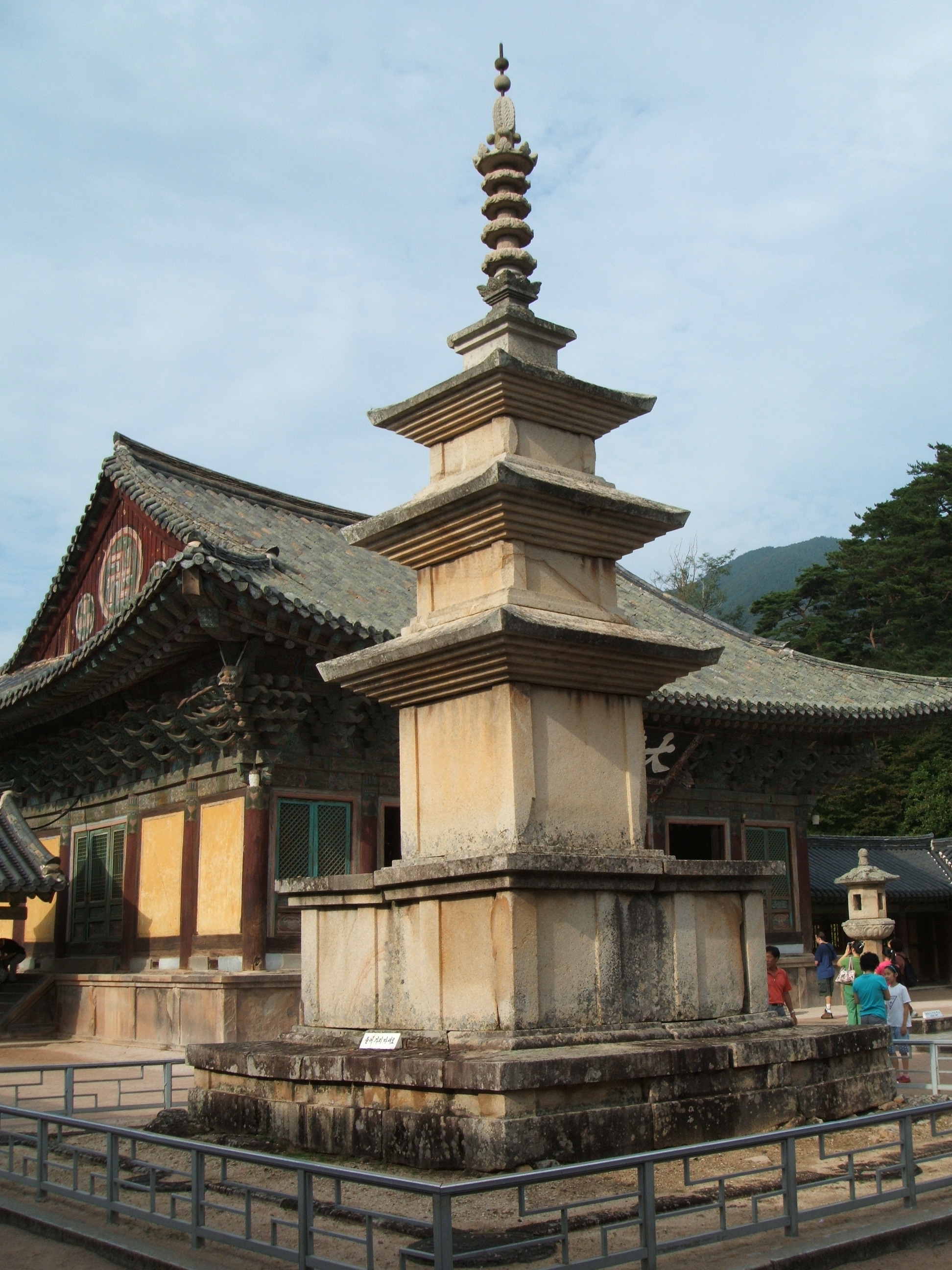- Seokgatap
Infobox Korean name

hangul=석가탑
hanja=釋迦塔
rr=Seokgatap
mr=Sŏkkat'apSeokgatap (
Sakyamuni Pagoda) is a stonepagoda inSouth Korea designated as the 21st National Treasure onDecember 12 ,1962 . Its full name is "Sakyamuni Yeoraesangjuseolbeop Tap", and is sometimes referred to as the Shadowless Pagoda or the "Bulguksa Samcheung Seoktap" ("three-storied stone pagoda of Bulguksa").The pagoda stands 8.2 meters high, directly across from
Dabotap within theBulguksa Temple complex inGyeongju ,South Korea . It was completed probably around 751, when the Bulguksa was completed.Description
The Seokgatap pagoda is in distinct contrast with its more elaborate brother the
Dabotap . The pagoda is of a very simple and basic design and the three stories have a pleasing 4:3:2 ratio which gives the pagoda a sense of balance, stability, and symmetry. The contrast between the simplicity of the Seokgatap and the complexity of the Dabotap is designed to represent the dual nature of the Buddha's contemplation and detachment from the world or perhaps it symbolizes the celestial versus the terrestrial. The pagoda's three stories rest on a two tiered base. The simplicity of the pagoda is reinforced by the fact that there are no carvings or reliefs on the faces of the pagoda. Although, the pagoda is surrounded by eight lotus flower stones. The top of the pagoda, which is rather elaborate, was added in 1973 to match a pagoda that was built one hundred years after Seokgatap.Construction
The pagoda, and its brother, was said to have been built by the stone mason, Asadal of
Baekje . He left his young wife at home while he went to direct the long project of building the pagodas and soon became so immersed in his work that he neglected his wife. When she went to see him, she was turned away from the temple because women were not allowed on the grounds at the time. Asadal's wife was directed to Shadow Pond where she would be able to see her husband in the water's reflection. When she looked into the water, all she could see was the completed Dabotap with no one in sight on the temple grounds. In anguish, Asadal's wife threw herself into the pond and drowned. Unknown to her, though, was that Asadal had finally finished Dabotap and was working on Seokgatap. This is why Seokgatap is known as the Shadowless Pagoda because Asadal's wife did not see the pagoda in the pond.Discovery of treasures
In 1966, the monks of the temple were awakened by sounds of exploding dynamite. They discovered that thieves had attempted to blast the pagoda and steal what was hidden inside. The thieves ran away before they could steal any of the treasures but the Buddhist monks discovered precious reliquaries, sariras, and the oldest extant example of printed material from a wood block in the world.
National treasure No.126
A sarira is a reliquary that contains the remains of an esteemed monk or sometimes royalty. After the failed theft by robbers, workers refurbishing and repairing the pagoda found the treasures hidden inside. Notably, the
Dabotap pagoda was dismantled by the Japanese for repairs during the 1920s but no record mentions any treasure recovered. Treasures included a bronze image of a Buddhist spirit, a bronze mirror, a miniature wooden pagoda, silk, perfume,gogok , and beads. A bundle of papers were found in the foundation of the pagoda but they are illegible.The sarira box is shaped like a house, and has an engraved roof. Each of the walls of the case have an engraved vine pattern that runs up to the roof. Lotus motifs are used throughout as well and the top of the roof has a leaf-shaped ornamentation.
The oldest extant woodblock print is a copy of the
Mugujeonggwang Great Dharani Sutra . The text is the oldest extant printed material in the world for several reasons. Firstly, the text contain archaic Chinese characters used only during the reign of Tse-tien Wu-hou who ruled Tang China from 624 to 705. Secondly, since the pagoda itself was built in 751, the print had to have been made before that date and no other printed material dates before 750–751 CE. It is 620 centimeters in length and eight centimeres in width. The print contains, on average, eight to nine characters per line. The print has deteriorated due to oxidixation and restorations in1988 and1989 were carried out to preserve the print.ee also
*
National treasures of Korea
*Bulguksa Temple References
*cite web|title=Oriental architecture|work=Bulguksa Temple|url=http://www.orientalarchitecture.com/kyongju/bulguksaindex.htm=May 3|accessyear=2006
*cite web|title=Cultural Heritage Online|work=Seokgatap|url=http://www.cha.go.kr/english/search_plaza/ECulresult_Db_View.jsp?VdkVgwKey=11,00210000,37&queryText=V_EKDCD='11'&requery=0=May 3|accessyear=2006
* [http://www.cha.go.kr/english/search_plaza/ECulresult_Db_View.jsp?VdkVgwKey=11,01260000,37 Cultural Heritage Online: National Treasure No.126]
Wikimedia Foundation. 2010.
